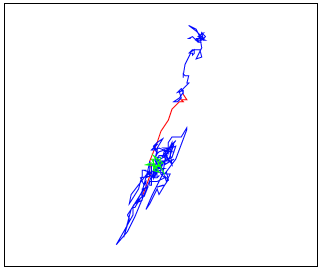Section: New Results
Classification of diffusion dynamics from particle trajectories
Participants : Vincent Briane, Charles Kervrann.
In this study, we are currently interested in describing the dynamics of particles inside live cell. Inference on the modes of mobility of molecules is central in cell biology since it reflects the interactions between the structures of the cell. In this work, we assume that the motions of particles follow a certain class of random process: the diffusion processes. Diffusions are stochastic processes with continuous paths and can model a large range of intracellular movements. Biophysicists distinguish three main types of diffusions, namely Brownian motion, superdiffusion and subdiffusion. These different diffusion processes correspond to distinct biological scenarios. A particle evolving freely inside the cytosol or along the plasma membrane is modelled by Brownian motion; the particle does not travel along any particular direction and can take a very long time to go to a precise area in the cell. Active intracellular transport can overcome this difficulty so that motion is faster in a given direction. In this case, particles are carried by molecular motors along microtubular filament networks and their motion is modelled with superdiffusion. Subdiffusion can be observed in two cases i/ when the particle is confined in a microdomain, ii/ when the particle is hindered by molecular crowding and encounters dynamic or fixed obstacles.
To address several issues in dynamics classification, we have developed a statistical test for classifying the observed trajectories into the three groups of diffusion of interest, namely Brownian motion, super-diffusion and subdiffusion. We have also designed an algorithm to detect the changes of dynamics along a single trajectory (see Fig. 5). We define the change points as the instants at which the particle switches from one diffusion type (Brownian motion, superdiffusion or subdiffusion) to another one. Finally, we have combined a clustering algorithm with our test procedure to identify micro domains, that is, zones where the particles are confined. Molecular interactions of great importance for the functioning of the cell take place in such areas.
Collaborators: Myriam Vimond (ENSAI Rennes),
Jean Salamero (UMR 144 CNRS-Institut Curie).



